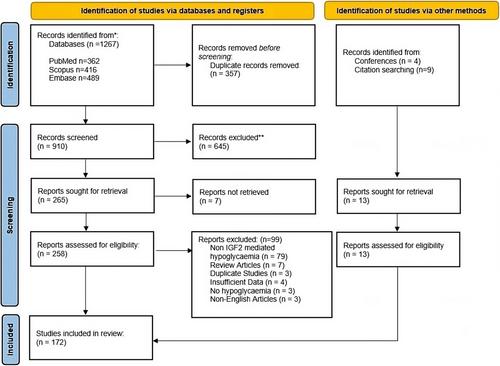A systematic review of literature on Insulin-like growth factor-2-mediated hypoglycaemia in non-islet cell tumours
Abstract
Introduction
Insulin-like growth factor-2 (IGF-2)-mediated hypoglycemia is a rare yet clinically significant entity with considerable morbidity and mortality. Existing literature is limited and fails to offer a comprehensive understanding of its clinical trajectory, management and prognostication.
Methods
Systematic review of English-language articles reporting primary patient data on IMH was searched using electronic databases (PubMed, Scopus and Embase) from any date up to 21 December 2022. Data were analysed in STATA-16.
Results
The systematic review contains 172 studies, including 1 Randomised controlled trial, 1 prospective observational study, 5 retrospective observational studies, 150 case reports, 11 case series and 4 conference abstracts. A total of 233 patients were analysed, averaging 60.6 ± 17.1 years in age, with comparable proportions of males and females. The commonest tumours associated with Insulin-like Growth Factor-2-mediated hypoglycaemia were fibrous tumours (N = 124, 53.2%), followed by non-fibrous tumours originating from the liver (N = 21, 9%), hemangiopericytomas (N = 20, 8.5%) and mesotheliomas (N = 11, 4.7%). Hypoglycaemia was the presenting feature of NICT in 42% of cases. Predominant clinical features included loss of consciousness (26.7%) and confusion (21%). The mean IGF-2 and IGF-1 levels were 882.3 ± 630.6 ng/dL and 41.8 ± 47.8, respectively, with no significant correlation between these levels and patient outcomes. Surgical removal was the most employed treatment modality (47.2%), followed by medication therapy. The recovery rate was 77%, with chronic liver disease (CLD) significantly associated with a poor outcome (OR: 7.23, P: 0.03). Tumours originating from fibrous tissues were significantly associated with recovery (p < .001). In the logistic regression model, CLD remained a significant predictor of poor outcomes.
Conclusion
This systematic review highlights that most non-islet-cell tumour-hypoglycaemia (NICTH) is due to fibrous tumours. NICTs demonstrate a variable prognosis, which is fair if originating from fibrous tissue. Management such as octreotide, corticosteroids, diazoxide, embolization, radiotherapy and surgical resection have disparate success rates.


 求助内容:
求助内容: 应助结果提醒方式:
应助结果提醒方式:


